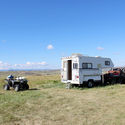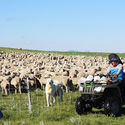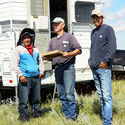Last shepherd in Blaine County?
October 19, 2016
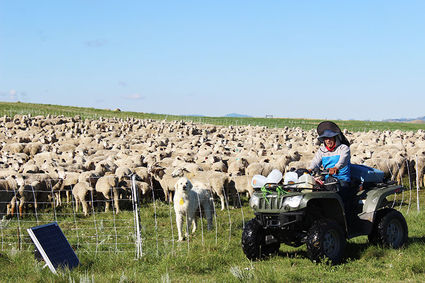
Steve Edwards
Raphael, a shepherd from Peru, arrives at where the sheep have been penned overnight. The portable, electrified 'netting' rolls up by section for moving to the next site. The netting keeps the sheep together and predators away. One of three guard dogs, a breed native to Turkey, is also shown in the photo.
Reporter's note: Last winter Max Hofeldt, a longtime sheep producer in the Chinook area, told me a producer from eastern Washington state would be bringing a flock of ewes and lambs to pasture south of Chinook for the summer. Max was reducing his lamb-ewe operation and would be leasing pasture to Tom Clyde, with the Standing O Ranch in Connell, Washington. Max met Tom Clyde at a sheep sale and the two struck an arrangement for Clyde to bring 1250 ewes and 1645 lambs to Blaine County in early May.
I'd heard, since arriving in Blaine County, about the role sheep had played as the area was settled and developed. Max said he believed the last fulltime shepherd in the area was Art Ingamon, nicknamed "Magpie," a herder who worked for Max until the mid-1970's. I was hoping to interview a real shepherd.
It all sounded easy, except the shepherd was from Peru and spoke no English. I contacted Laura Kellam, the Spanish teacher at Chinook High, and she agreed to help as an interpreter. As a fallback position, I wrote out a series of questions and used Google Translate, a computer program, to state the questions in Spanish. Laura edited the questions so they made sense, as the program doesn't take into account the context of words translated.
Here's the story of Raphael, likely the 'last shepherd in Blaine County.'
Raphael makes camp in Blaine County
The nearly 3,000 ewes and lambs arrived on May 4, just in time for the last blizzard of the season. Tom Clyde, who owns the sheep, said later, "Max warned me about the possibility of a late cold snap. Looking back, we brought the sheep too early and were caught unprepared." Clyde said he lost about 200 sheep during the storm event, mostly lambs.
In late July Max invited me to go with him, and his son Levi, to meet the sheepherder and interview him. The Spanish teacher was in California so the interview consisted of sign language, a few words and phrases we could share, photos on a smartphone that the shepherd had and a Spanish/English dictionary that Raphael had in his living quarters.
Max, Levi and I arrived at the camp. It was still early in the morning and the sheep were all in a portable electric pen (electric netting) powered by a solar cell. Tom Clyde explained, "The portable netting allows some protection for the sheep at night. The electrified netting is a good defense against predators, especially coyotes." Three large, white guard dogs were in the pen with the sheep and the dogs put up a fuss as soon as we walked up to the pen.
Clyde explained about the dogs. They are a breed, native to western Turkey, called Akbash and bred for guarding livestock, especially sheep. Clyde added, "Basically the dogs protect by intimidation. They will bark and chase a coyote but are unlikely to be able to catch them." A male Akbash, at maturity, can weight up to 200 pounds.
Raphael soon arrived on a four-wheeler, with Spanish music playing. He was bundled up and wearing two hats because there had been a rain shower earlier. The four wheeler had several charging cables for electronic devices. He also had a rifle attached to the machine and some jugs for water and other equipment he obviously carried most of the time.
We followed him to his living quarters-a slide-in pickup camper on a trailer. He had propane for heat and to power a small refrigerator. Other gear was piled around the camper. As Max and Levi separately hitched up to the camper/trailer and a stock trailer with additional supplies, Levi said, "We'll need to find a high point as he likes to have access to a 3G signal for his smartphone." The smartphone was one of several adaptations I noticed were used by the modern-day shepherd.
Once the camp was moved and the groceries stowed, Max drew a map to show Raphael where he was to graze the sheep in the new area. Max explained, "In the old days there was no need for fences to control the sheep, the shepherd handled them. Even now, I can let the sheep graze near grain we've planted because the shepherd will keep them out of the fields." I did notice that in just the few minutes since the pens had been removed the sheep were helter-skelter across the rolling pasture. Max said, "Oh, he'll get them rounded up pretty quickly once we leave."
The life of a modern shepherd In some responses to my questions, Raphael wrote that he had been working with sheep since he was eight years old. He came from a small village and had a wife and two children back in Peru. Max said, "I'm responsible for his needs while he's here. He gives me a grocery list, which I take to the store and fill." Raphael writes this list in Spanish but often lists brands rather than the names of foods. On one of his first shopping trips Max found a clerk, who had grown up in Texas, and was fluent in Spanish. She helped him identify and find the groceries on the list.
The sheep are on a 4000-acre plot that has an old farmstead on it. The shepherd gets his drinking water and can use the shower at the farmstead. His living quarters, which came with him from Washington, are pretty well equipped and the Hofeldts bring supplies on a regular basis. He has a phone which he can use if he has an emergency need.
Tom Clyde explained that Raphael was one of thousands of H-2A agricultural workers who come to the U.S. to fill labor shortages. He said, "I doubt it would be possible to hire a U.S. citizen as a shepherd, for lack of interest and no skills needed to tend sheep." While shepherds make up many of the workers in the H-2A program, it's also used to fill jobs for fruit pickers, Christmas tree cutters and many other agricultural jobs.
Clyde said, "The workers are recruited by groups that specialize in finding labor. As an employer, I pay a monthly fee for the worker they provide." The transportation to the work site is paid for by the employer as well as some health insurance and other requirements. Clyde added, "There's reams of paperwork for the employer but the recruiting groups vet the candidates and make sure they meet the requirements of the embassies. A few of the people leave and become fugitives among the other undocumented people in the country." The employees make a commitment for a three-year contract.
This particular shepherd, Clyde told, makes $1250 a month, with living expenses covered. Clyde said, "A school teacher in Peru makes about $400 a month. Our shepherds can save about $1200 a month, the majority of which they send back home." Raphael has a wife and two children-has photos of his family on his smartphone and is happy to show the photos to visitors.
Asked to describe some of the challenges of being a shepherd, Raphael wrote, "over time one develops an ability to deal with the solitude in order to support his family and cope with the poverty in Peru." Rattlesnakes, which Raphael described with elaborate hand signals and voice sounds, is a hazard he doesn't like in Montana. In his written comments he used the word "jingle bells" to describe the snakes. Laura Kellam, the interpreter, said, "He probably didn't know the Spanish word for rattlesnake so used 'jingle bells' to describe the snake's insistent, alarming sound. It took a while to figure that one out."
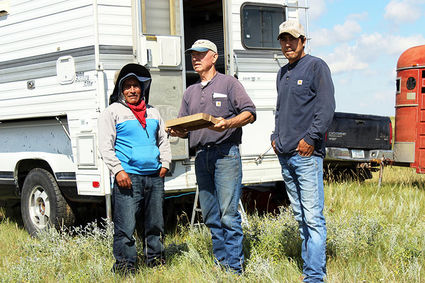
Steve Edwards
(Left to right) Raphael, a shepherd from Peru, gets instructions from landowners Max and Levi Hofeldt. Max is using a hand drawn map to show the area where about 1200 ewes and 1600 lambs are being grazed south of Chinook.
Return engagement for the shepherd?
Tom Clyde said, "Bringing the sheep to Montana has worked out pretty well, except for getting them here a bit early." He will sell the lambs, via a video sales group based in Billings, at the end of August. The lambs will ship to buyers in late September and the ewes will be trucked back to Washington in early October. Clyde added, "Max and I haven't really talked about a next time. A lot of it will depend on the market for the lambs we sell this year. At this point I'm not opposed to the idea of trying the process again."
So, readers should not expect a ground swell of shepherds moving into the area. But, given the right conditions, seeing a shepherd out on the prairie may not be completely out of the question. The shepherds are practitioners of a profession that predates the Old Testament. It's actually nice to see a bit of the old days back in our part of the world.

